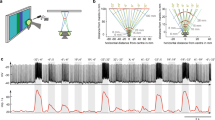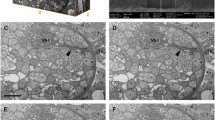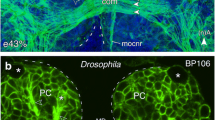Summary
The structure of optic cartridges in the frontal part of the lamina ganglionaris (the outermost synaptic region of the visual system of insects) has been analysed from selective and reduced silver stained preparations. The results, obtained from studies on five different species of Diptera, confirm that six retinula cells, together situated in a single ommatidium, project to six optic cartridges in a manner no different from that described by Braitenberg (1967) from Musca domestica. Each optic cartridge contains five first order interneurons (monopolar cells) which project together to a single column in the second synaptic region, the medulla. The dendritic arrangement of two of these neurons (L1 and L2) indicates that they must make contact with all six retinula cell terminals of a cartridge (R1–R6). Two others (L3 and L5) have processes that reach to only some of the retinula cell endings. A fifth form of monopolar cell (L4) sometimes has an arrangement of processes which could establish contact with all six retinula cells: other cells of the same type may contact only a proportion of them. This neuron (L4) also has an arrangement of collaterals such as to allow lateral interaction between neigbouring optic cartridges. The processes of the other four monopolar cells (L1, L2, L3 and L5) are usually contained within a single cartridge. In addition to these elements there is a pair of receptor prolongations (the long visual fibres, R7 and R8) that bypasses all other elements of a cartridge, including the receptor terminals R1–R6, and finally terminates in the medulla. Four types of neurons, which are derived from perikarya lying just beneath or just above the second synaptic region, send fibres across the first optic chiasma to the lamina. Like all the other interneuronal elements of cartridges the terminals of these so-called “centrifugal” cells have characteristic topographical relationships with the cyclic arrangement of retinula cell terminals. Apart from the above mentioned neurons there is also a system of tangential fibres whose processes invade single cartridges but which together could provide a substrate for relaying information to the medulla derived from aggregates of cartridges.
Optic cartridges contain at least 15 neural elements other than retinula cells. This complex structure is discussed with respect to the receptor physiology, as it is known from electrophysiological and behavioural experiments. The arrangements of neurons in cartridges is tentatively interpreted as a means of providing at least 6 separate channels of information to the medulla, four of which may serve special functions such as relaying color coded information or information about the angle of polarised light at high light intensities.
Similar content being viewed by others
References
Autrum, H. J., Wiedemann, I.: Versuche über den Strahlengang im Insektenauge (Appositionsauge). Z. Naturforsch. 17 b, 480–482 (1962).
Bishop, L. G., Keehn, D. G., McCann, G. D.: Motion detection by interneurons of optic lobes and brain of the flies Calliphora phaenicia and Musca domestica. J. Neurophysiol. 31, 509–526 (1968).
Blackstadt, T. W.: Electron microscopy of Golgi preparations for the study of neuronal Relations. In: Contemporary research methods in neuroanatomy, ed. W. J. H. Nauta & S. O. E. Ebesson. Berlin-Heidelberg-New York: Springer 1970.
Blest, A. D.: Some modifications of Holme's silver nitrate method for insect central nervous system. Quart. J. micr. Sci. 102, 413–417 (1961).
—, Collett, T. S.: Micro-electrode studies of the medial protocerebrum of some Lepidoptera. 1. Response to simple, binocular visual stimulation. J. Insect Physiol. 11, 1079–1103 (1965a).
—: Micro-electrode studies of the medial protocerebrum of some Lepidoptera. 2. Responses to visual flicker. J. Insect Physiol. 11, 1289–1306 (1965b).
Boschek, C. B.: On the structure and synaptic organisation of the first optic ganglion in the fly. Naturforsch. 25b, 5 (1970a).
- On the fine structure of the peripheral retina and Lamina ganglionaris of the Fly Musca domestica. Inaugural Dissertation for Doctors degree. University of Tübingen (1970 b)
Boycott, B. B., Gray, E. G., Guillery, R. W.: Synaptic structure and its alteration with environmental temperature: a study by light and electron-microscopy of the central nervous system of Lizards. Pro. roy. Soc. B 154, 151–172 (1961).
Braitenberg, V.: Unsymmetrische Projektion der Retinulazellen auf die Lamina ganglionaris bei der Fliege Musca domestica. Z. vergl. Physiol. 52, 212–214 (1966).
—: Patterns of projection in the visual system of the fly. 1. Retina-lamina projections. Exp. Brain. Res. 3, 271–298 (1967).
—: On the neural optics behind the eye of the fly. In: Proceedings of the International School Physics “Enrico Fermi” Course XLIII, ed. W. Reichardt. New York: Academic Press 1969.
—: Ordnung und Orientierung der Elemente im Sehsystem der Fliege. Kybernetik 7, 235–242 (1971).
—, Guglielmotti, V., Sada, E.: Correlation of crystal growth with the staining of axons by the Golgi procedure. Stain Technol. 42 (6), 277–283 (1967).
Burkhardt, D., Wendler, C.: Ein direkter Beweis für die Fähigkeit einzelner Sehzellen des Insektenauges, die Schwingungsrichtung polarisierten Lichtes zu analysieren. Z. vergl. Physiol. 43, 687–692 (1960).
Cajal, S. R.: Nota sobre la retina de la mosca (M. vomitoria L). Trab. Lab. Invest. biol. Univ. Madr. 7, fasc 4, 217 (1909).
—, Sanchez, D.: Contribucion al conocimiento de los centros nerviosos de los insectos. Parte 1. Retina y centros opticos. Trab. Lab. Invest. Biol. Univ. Madr. 13, 1–168 (1915).
Chen, J. S., Chen, M. G. M.: Modifications of the bodian technique applied to insect nerves. Stain Technol. 44 (1), 50–51 (1969).
Collett, T. S.: Centripetal and centrifugal visual cells in the medulla of the insect optic lobe. J. Neurophysiol. 33, 239–256 (1970).
—, Blest, A. D.: Binocular, directionally selective neurons possibly involved in the optomotor response of insects. Nature (Lond.) 212, 1330–1333 (1966).
Colonnier, M.: The tangential organization of the visual cortex. J. Anat. (Lond.) 98, 327–344 (1964).
Dietrich, W.: Die Facettenaugen der Dipteren. Z. wiss. Zool. 92, 465–539 (1909).
Eccles, J. C., Ito, M., Szentágothai, J.: The cerebellum as a neuronal machine. Berlin-Heidelberg-New York: Springer 1967.
Eckert, H.: Verhaltensphysiologische Untersuchungen am visuellen System der Stubenfliege Musca domestica L. (Bestimmung des optischen Auflösungsvermögens, des Reizeinzugsgebiets und der relativen spektralen Empfindlichkeit in Abhängigkeit vom Lichtfluß im Komplexauge). Doctoral dissertation, University of Berlin (Manuskript) (1970).
Eichenbaum, D. M., Goldsmith, T. H.: Properties of intact photoreceptor cells lacking synapses J. exp. Zool. (v), 169 (I), 15–32 (1968).
Frisch, K. v.: Tanzsprache und Orientierung der Bienen. Berlin-Heidelberg-New York: Springer 1965.
Götz, K. G.: Flight control in Drosophila by visual perception of motion. Kybernetik 4 (6), 199–208 (1968).
Holschuh, H.: Örtliche Variation der Struktur in der Lamina ganglionaris der Fliege Musca domestica im Zusammenhang mit der örtlichen Variation der optomotorischen Reaktion. Diploma Dissertation, University of Tübingen (1970).
Horridge, G. A., Meinertzhagen, I. A.: The accuracy of the patterns of connexions of the first - and second - order neurons of the visual system of Calliphora. Proc. roy. Soc. B 175, 69–82 (1970).
—, Scholes, J. H., Shaw, S., Tunstall, J.: Extracellular recordings from single neurons in the optic lobe and brain of the locust. In: The physiology of the insect central nervous system, ed. E. Treherne and J. W. L. Beament. London: Academic Press 1965.
Kaiser, W., Bishop, L. G.: Directionally selective motion detecting units in the optic lobes of the honeybee. Z. vergl. Physiol. 67, 403–413 (1970).
Kirschfeld, K.: Optics of the compound eye. In: Processing of optical data by organisms and machines (Proc. Int. School Phys. “Enrico Fermi”), ed. W. Reichardt. Course XLIII. New York: Academic Press 1969.
—: Die Projektion der optischen Umwelt auf das Raster der Rhabdomere im Komplexauge von Musca. Exp. Brain Res. 3, 248–270 (1967).
—, Franceschini, N.: Optische Eigenschaften der Ommatidien im Komplexauge von Musca. Kybernetik 5 (2), 47–52 (1968).
—: Ein Mechanismus zur Steuerung des Lichtflusses in den Rhabdomeren des Komplexauges von Musca. Kybernetik 6, 13–22 (1969).
- Reichardt, W.: Optomotorische Versuche an Musca mit linear polarisiertem Licht. Z. Naturforsch. 25 B (2), (1970).
Langer, H.: Grundlagen der Wahrnehmung von Wellenlänge und Schwingungsebene des Lichtes. Verh. dtsch. Zool. Ges. (Göttingen), 195–233 (1967).
Mazokhin-Porshnyakov, G. A.: Insect vision. New York: Plenum Press 1969.
McCann, G. D., Dill, J. C.: Fundamental properties of intensity, form and motion perception in the visual nervous system of Calliphora phaenicia and Musca domestica. J. gen. Physiol. 53, 385–413 (1969).
Melamed, J., Trujillo-Cenóz, O.: The fine structure of the central cells in the ommatidia of Dipterans. J. Ultrastruct. Res. 21, 313–334 (1968).
Meyer, G.: Versuch einer Darstellung von Neurofibrillen im zentralen Nervensystem verschiedener Insekten. Zool. Jb. Abt. Anat. u. Ontog. 71 (3), 413–431 (1951).
Pearson, L.: The corpora pedunculata of Sphinx liquistri and other Lepidopteren: an anatomical study. Phil. Trans. roy. Soc. Lond. (in press) (1970).
Power, M. E.: The brain of Drosophila melanogaster. J. Morph. 72 (3), 517–559 (1943).
Reichardt, W.: Movement perception in insects. In: Processing of optical data by organisms and machines (Proc. Int. School Phys. “Enrico Fermi”), ed. W. Reichardt. Cours XLIII. New York: Academic Press 1969.
—: Quantum sensitivity of light receptors in the compound eye of the fly Musca Cold. Spr. Harb. Symp. quant. Biol. 30, 505–515 (1969).
Steiger, U.: Über den Feinbau des Neuropils im Corpus pedunculatum der Waldameise. Z. Zellforsch. 81, 511–530 (1967).
Stell, W. K.: The structure and relationships of horizontal cells and photoreceptor-bipolar synaptic complexes in Goldfish retina. Amer. J. Anat. 120, 401–414 (1967).
Strausfeld, N. J.: Golgi studies on insects. Part II. The optic lobes of Diptera. Phil. Trans. Roy. Soc. Land. B 258, 135–223 (1970a).
—: Variations and invariants of cell arrangements in the nervous systems of insects. (A review of neuronal arrangements in the visual system and corpora pedunculata). Verh. Zool. Ges. (Köln) 64, 97–108 (1970b).
- Golgi studies on insects: interommatidial receptors at the retinal surface. Manuscript. Ph. D. thesis (University of London). Part 3. 244–251 (1970 c).
—, Blest, A. D.: Golgi studies on insects. Part I. The optic lobes of Lepidoptera. Phil. Trans. Roy. Soc. Lond. B 258, 81–134 (1970).
—, Braitenberg, V.: The compound eye of the fly (Musca domestica): connections between the cartridges of the lamina ganglionaris. Z. vergl. Physiol. 70, 95–104 (1970).
Trujillo-Cenóz, O.: Some aspects of the structural organization of the intermediate retina of Dipterans. J. Ultrastruct. Res. 13, 1–33 (1965).
—: Compound eye of Dipterans—anatomical basis for integration. J. Ultrastruct. Res. 16, 395–398 (1966).
Trujillo-Cenóz, O.: Some aspects of the structural organisation of the Medulla in Muscoid flies. J. Ultrastruct. Res. 27, 533–553 (1969).
—, Melamed, J.: Electron microscope observations on the peripheral and intermediate retinas of Dipterans. In: The functional organization of the compound eye, ed. C. G. Bernhard. London: Pergamon Press 1966.
—: Light and Electronmicroscope study of one of the systems of centrifugal fibres found in the lamina of Muscoid flies. Z. Zellforsch. 110, 336–349 (1970).
Vigier, P.: Mécanisme de la synthèse des impressions lumineuses recueillies par les yeux composés des Dipteres. C. R. Acad. Sci. (Paris), 122–124 (1907 a).
- Sur les terminations photoréceptrices dans les yeux composés des Muscides. C. R. Acad. Sci. (Paris), 532–536 (1907 b).
- Sur la réception de l'excitant lumineux dans les yeux composés des Insectes, en particulier chez les Muscides. C. R. Acad. Sci. (Paris), 633–636 (1907 c).
- Sur l'existence réelle et le rôle des appendices piriformes des neurons. La neurone périoptique des Diptères. C. R. Soc. Biol. (Paris), 959–961 (1908).
Vries, H. de, Kuiper, J. W.: Optics of the insect eye. Conference on photoreception. Ann. N. Y. Acad. Sci. 74, 146–203 (1958).
Werblin, F. S., Dowling, J. E.: Organization of the retina of the Mudpuppy Necturus maculosus. II. Intracellular recording. J. Neurophysiol. 32, 339–355 (1969).
Wiedemann, I.: Versuche über den Strahlengang im Insektenauge (Appositionsauge). Z. vergl. Physiol. 44, 526–542 (1965).
Zettler, F., Järvilheto, M.: Histologische Lokalisation der Ableitelektrode. Belichtungs-potentiale aus Retina und Lamina bei Calliphora. Z. vergl. Physiol. 68, 211–228 (1970).
Author information
Authors and Affiliations
Additional information
Part of the work for this account was carried out at the Zoologisches Institut, Frankfurt am Main with the support of an Alexander von Humboldt Stipendium: I thank Professor D. Burkhardt for the hospitality extended to me there. The investigations were completed at the Max-Planck-Institut für biologische Kybernetik. I am grateful to Dr. V. Braitenberg, Dr. K. Kirschfeld and Dr. K. Götz for reading the manuscript in its entirety and for their most constructive criticisms and suggestions. I thank Prof. G. D. McCann (California Institute of Technology) for hospitality and facilities which enabled some of the experimental staining procedures to be developed, and to Mrs. Jane Chen (U.C.L.A.) who played the major part in refining the Bielschowsky modification. Miss E. Hartwieg and Miss M. Obermayer, Tübingen, gave valuable technical assistance. I would also like to thank Mrs. K. Schwertfeger for the assiduous preparation of the manuscript and Mr. F. Freiberg for the execution of Fig. 13.
Rights and permissions
About this article
Cite this article
Strausfeld, N.J. The organization of the insect visual system (Light microscopy). Z. Zellforsch. 121, 377–441 (1971). https://doi.org/10.1007/BF00337640
Received:
Issue Date:
DOI: https://doi.org/10.1007/BF00337640




